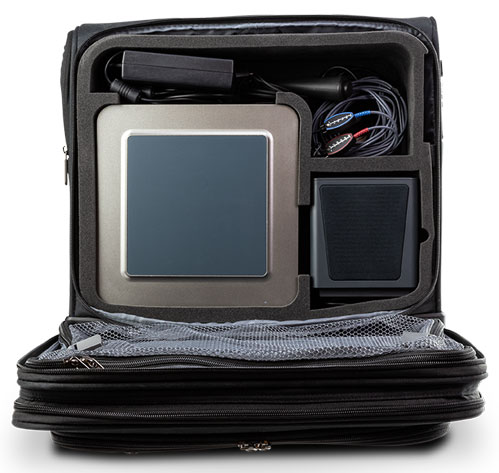Join the Interacoustics community and receive news about new products, events and much more
8 significant benefits of using a dedicated keyboard for audiometry
When it comes to performing audiometry, having the right equipment can make all the difference. The traditional standalone audiometer and its PC-based counterpart are both good options, but both still come with their own set of limitations:
- With a standalone audiometer, data handling is more manual.
- With a PC-based audiometer, using the PC keyboard can influence your focus on the patient.
But what if there’s a way we can get all the benefits of PC-based audiometry with the familiarity of a standalone audiometer? Enter Interacoustics’ Audiometer Keyboard, which is a dedicated keyboard for audiometry that works with Affinity Compact, Affinity, and Equinox.
So, whether you’re tired of the limitations of your standalone audiometer, frustrated with the complexity of your current keyboard, or looking to upgrade your PC-based setup, keep reading to discover eight significant benefits of using the Audiometer Keyboard.
1. Get the touch and feel of a standalone audiometer
If you’re in the position of going from a standalone audiometer to a PC-based audiometer, the transition should be easy.
The Audiometer Keyboard supports a seamless transition from the PC keyboard and is available as an interim option where you get the best of both worlds – the data security and efficiency of PC-based audiometry with the touch and feel of a standalone audiometer.
2. Reduce the risk of leading your patient
The Audiometer Keyboard is almost silent, allowing you to press switches and keys without interfering with the actual flow of the test, especially if you’ve got the patient in the room with you and not in a separate booth.
This means you’re not going to give any clues or indications to the patient of when to press the patient response button. For example, if you’re using a PC keyboard, it can be easier for the patient to see or hear what you’re doing rather than if you’ve got your hands on the Audiometer Keyboard’s dials, where it’s much easier to be discrete when you’re presenting stimuli.
3. Increase the focus on your patient
When you’re driving a car, you may find yourself looking down at the speedometer to avoid driving too fast. Especially if there are a lot of speed cameras. You’re juggling between the need to keep an eye on your speed and your most important job – to focus on the road ahead of you.
And it’s exactly the same thing when sat across your patient. To increase the validity of your test results and make the testing experience as pleasant as possible, you want to be focusing on your patient as much as possible and not looking down too much.
Especially when you’re reaching the higher intensities, such as when performing UCLs, it’s important to ensure patient safety at all times. Sometimes, the patient will think “I’ll be brave and take it” but you can see them squinting. You need to be observant for that and not being distracted by anything else. This is where the touch and feel of the dedicated keyboard will allow you to increase the focus on your patient.
4. Tailor the Audiometer Keyboard to your workflow
Another benefit is the Audiometer Keyboard’s nine customizable F-keys. Depending on your workflow, you can have something set for yourself and in a way that works for you.

5. Stay on top of your clinical hygiene
The design of the keyboard means that it’s hygienic and the keys are not like a normal PC keyboard, where they can come apart. You also avoid the small gaps around and between the keys, which allow for a hotbed of dirt and bacteria to be lodged between them!
In clinical environments where you need to be on top of your hygiene, the keyboard is quick and easy to clean. Thanks to its gap-free, silicone surface, you can wipe it down effectively.
6. It helps to promote a clean-desk philosophy
The Audiometer Keyboard has a small footprint, which means it can sit side by side to your PC keyboard. Its slim, ergonomic, and chic design means you can have a stylish keyboard without it taking up a lot of desk space.

7. No installation or setup required
You’re likely super busy and don’t want to be spending too much time installing your equipment. Luckily, the Audiometer Keyboard is USB plug-and-play with no installation or setup required.
8. Bring it on the road if you’re a traveling audiologist
If you’re traveling as a community nurse or a community audiologist, you can combine the Audiometer Keyboard with Interacoustics’ Affinity Compact set up for audiometry. Then you’ve got a great package including your laptop which you could carry anywhere.

Breaking barriers in a world of changing technology
Footprints are getting smaller and hearing aids are getting smaller. It’s exciting to offer a keyboard that reflects these technological advancements.
For clinicians that are used to the workflow of a standalone audiometer and for students who are arriving in clinic after learning on a traditional audiometer, the Audiometer Keyboard will help to break the barrier of transitioning to a PC-based audiometer, thereby giving clinicians access to the benefits of working entirely PC‑based.
For more information about this solution, visit Interacoustics’ Audiometer Keyboard.
About the author
Rasna Kaur Mistry, BSc (Hons) Audiology, graduated from The University of Manchester in 2007. Before joining Interacoustics in 2022, Rasna held several clinical audiology roles in the UK.
Similar Topic
Stay up to date!
Subscribe to our newsletter and receive news on new products, seminars and much more.
By signing up, I accept to receive newsletter e-mails from Interacoustics. I can withdraw my consent at any time by using the ‘unsubscribe’-function included in each e-mail.
Click here and read our privacy notice, if you want to know more about how we treat and protect your personal data.
